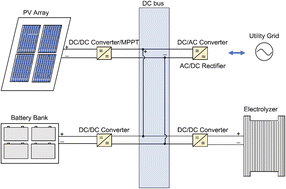Optimal design of a coupled photovoltaic–electrolysis-battery system for hydrogen generation†
Abstract
A computational algorithm to model an integrated photovoltaic–electrolysis-battery system is presented with the goal of identifying the system's optimal size, from a Pareto front analysis perspective, that maximizes the hydrogen production rate, minimizes the levelized cost of energy (LCE) and total system's cost, while targeting a net-zero grid energy operation. Over 2 million sizing combinations were evaluated, and 10 were chosen as the Pareto front for this optimization problem, with hydrogen production capacities between 36–122 Nm3 h−1 and LCE values close to 0.2 $ per kW h. The results demonstrated that optimizing the system's cost and hydrogen production rate implicitly ensures LCE is minimized. The identified Pareto front serves as a design guide, enabling the design of arbitrary plant capacities by multiplying a Pareto optimal point by a factor, while guaranteeing the new point still lies within the Pareto front. This computational platform to model integrated solar-hydrogen systems can be extended to more complex hybrid systems.

- This article is part of the themed collection: Sustainable Energy & Fuels Emerging Investigators Series


 Please wait while we load your content...
Please wait while we load your content...